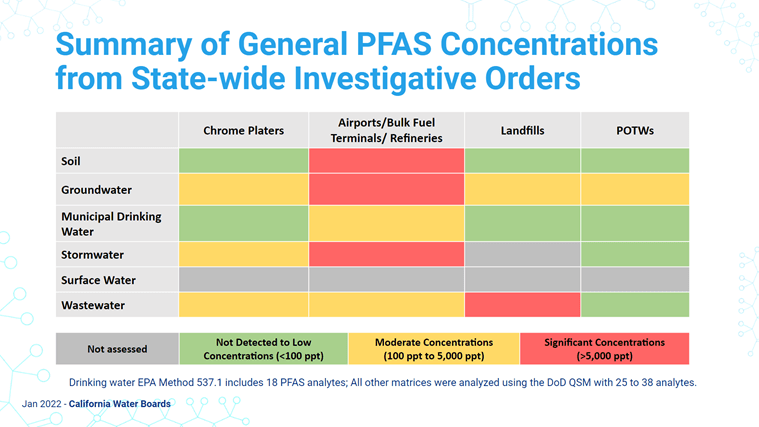New Data Redefines State of PFAS in California
LOS ANGELES – The partnership between science and policy has been on full display in California since the State Water Resources Control Board’s (SWRCB) Division of Water Quality (DWQ) and the Division of Drinking Water (DDW) initiated more than 2,000 state investigations into PFAS contamination. CDM Smith and the California Association of Sanitation Agencies (CASA) and their member agencies worked closely to analyze and interpret the unprecedented influx of raw PFAS data.
Understanding the sources and distribution of PFAS is now a priority for the U.S. government and states like California, which are tackling the PFAS problem via sampling orders. California has zeroed in on industries suspected to have sources of PFAS in their processes, like chrome platers, airports, and bulk fuel terminals and refineries. The state is also interested in how these significant dischargers impact recipients of PFAS, including wastewater treatment plants (WWTPs) and publicly owned treatment works (POTWs). The broad effort is designed to gain a better understanding of how the toxic compounds flow through potential exposure pathways.
In July 2020, the SWRCB sent an investigative order to more than 200 POTWs, requiring them to sample their influent, effluent, and biosolids on a quarterly basis for one year. The data collection is now complete and is posted on California’s GeoTracker PFAS Map. The state concurrently collected background data on industrial, and residential and commercial flow volumes into their plants. The agency asked each facility to report on the industry types contributing influent waste (i.e., airports, breweries, textiles, food processing plants, etc.).

The California Association of Sanitation Agencies, CASA, serves as a leading voice throughout California on issues related to wastewater and biosolids management. The association represents more than 125 local agencies that collect, treat and recycle wastewater and biosolids. As laid out in a 2020 report on forecasted biosolids cost increases related to PFAS, CASA has been concerned about the potential financial and management burdens placed on wastewater and biosolids processors as a result of current and pending regulations.
“From a policy perspective, placing responsibility on the producers of PFAS upstream of water utilities is far more preferable than the public bearing the cost through infrastructure upgrades when California is already facing a water crisis,” said Jared Voskuhl, CASA’s manager of regulatory affairs, at a recent industry workshop on PFAS in California.
Following the release of the investigative orders, CASA turned to CDM Smith for help characterizing PFAS contamination in the state, asking CDM Smith to put their expertise in data analysis and PFAS to work and analyze the sample results from the SWRCB investigative order.
CDM Smith’s evaluation of the dataset was designed to answer five main questions:
- Is there a “baseline” of PFAS flowing into POTWs from residential and commercial sources?
- Do industrial discharges result in PFAS above this baseline?
- Are signatures of PFAS from industrial point sources visible in the data?
- Where are the “outlier” POTWs receiving more PFAS compared to others?
- What are the blind spots or major uncertainties in the dataset?
Aflaki’s presentation, building on analysis from CASA Member Agency OC San and their engineering partner Ramboll, included a breakdown of the 272 facilities that had submitted PFAS monitoring data, in response to SWRCB Investigative Order (Order). The project team divided the data set into six bins according to the contribution percentages from residential & commercial sources. Most facilities (80%) receive less than 10% of their influent flow totals from industrial sources.
“I appreciate the unpacking of what is a lot of uncertainty and complexity,” said E. Joaquin Esquivel, the California State Water Boards Chair.
CDM Smith’s analysis of the data showed that many PFAS analytes were frequently not detected in the POTW samples. “With so many non-detects, it is important to use the distribution of PFAS primarily to identify outliers,” Aflaki reported. “This will help identify the POTWs that would benefit from source identification and source control studies.”
“I agree with you as well, Dr. Aflaki, really focusing on those outliers there can be helpful for the other systems, [determining] what’s going on and how best to address this in the long term,” Esquivel added.
Until now there has been limited data available due to the enormous scope of global PFAS presence and contamination, but initiatives like California’s statewide sampling investigation have been remedying that shortfall. With newly supplied data, CDM Smith has been able to use the state’s Geo Tracker Data to evaluate the scope of presence and contamination like never before. With newly supplied data, CDM Smith has been able to use the state’s Geo Tracker Data to evaluate the scope of presence and contamination more effectively. The California Water Board’s GeoTracker PFAS Map allows users to see the PFAS data by location and analyte.
Additional results of this massive sampling and evaluation project will be shared at future SWRCB hearings, CASA meetings, and industry conferences.
Chris Gurr, PFAS remedial investigation discipline leader at CDM Smith, has been advancing treatment and identification methods related to PFAS for several years. He believes the unprecedented data flow is changing how we see this global contamination event.
“Just one sample for PFAS can show one to two dozen detections of individual analytes,” Gurr said. “PFAS datasets are large, and as a result we can leverage computer programming and statistics a lot more than we’ve ever been able to do before when evaluating contamination.”
For the latest on this project and all other industry news related to PFAS, subscribe to Breaking Down PFAS.
CDM Smith is a privately owned engineering and construction firm providing legendary client service and smart solutions in water, environment, transportation, energy and facilities. Passionate about our work and invested in each other, we are inspired to think and driven to solve the world's environmental and infrastructure challenges.

PFAS datasets are large, and as a result we can leverage computer programming and statistics a lot more than we’ve ever been able to do before.



